The Teita Sisal Estate is one of the largest sisal estates in the world, and the largest in East Africa. It is located in Kenya's Taita-Taveta County, in the former Coast Province, near the town of Mwatate. The company is active in growing sisal and in manufacturing sisal goods such as rope, sacks and baling twine, at its manufacturing facility in Nairobi.
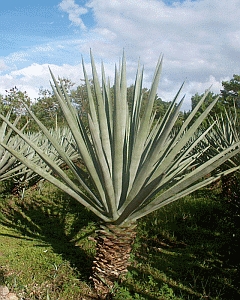
Sisal is a species of flowering plant native to southern Mexico, but widely cultivated and naturalized in many other countries. It yields a stiff fibre used in making rope and various other products. The sisal fibre is traditionally used for rope and twine, and has many other uses, including paper, cloth, footwear, hats, bags, carpets, geotextiles, and dartboards. It is also used as fibre reinforcements for composite fibreglass, rubber, and concrete products. It can also be fermented and distilled to make mezcal.

The geography of France consists of a terrain that is mostly flat plains or gently rolling hills in the north and west and mountainous in the south and the east. Metropolitan France has a total size of 551,695 km2 (213,011 sq mi). It is the third largest country in Europe by area and the largest in Western Europe.
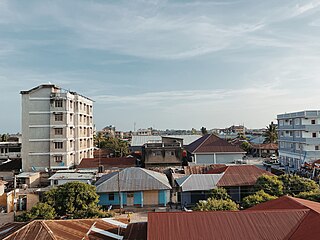
Tanga is a historic city and the capital of Tanga Region. The city is the most northernly port city of Tanzania to the west of the Indian Ocean on Tanga Bay. The city has a population of 393,429 in 2022. Tanga is governed by the Tanga City Council. The city is also home to the Port of Tanga. The name Tanga means "sail" in Swahili. The city is also the capital of Tanga District.

Ticul de Morales Municipality is one of the 106 municipalities in Yucatán State, Mexico. It is located in the western part of the state at 100 km south of the state capital city of Mérida. The municipality, which has an area of 355.12 km², in the 2005 census reported 25,621 inhabitants. The city of Ticul which is the municipal seat had a population of 21,147, the ninth-largest community in the state in population. The majority are ethnically Maya. Its largest other towns are Pustunich and Yotholín.
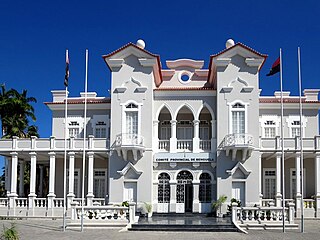
Benguela is a city in western Angola, capital of Benguela Province. Benguela is one of Angola's most populous cities with a population of 555,124 in the city and 561,775 in the municipality, at the 2014 census.
The Tansa River is a small river near Mumbai, India and is one of Mumbai's water sources via Tansa Lake. It is embanked by a dam built in 1892, which was then one of the largest masonry dams in the world. The embankment is nearly 2 miles long, 118 ft (36 m) high, and 30 metres thick at the base. The dam has 1.31 cubic kilometres capacity of water retention. The dam has about 38 spillway gates.
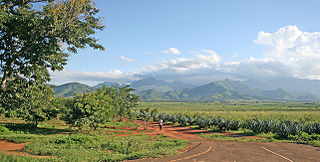
Morogoro Region is one of Tanzania's 31 administrative regions. The region covers an area of 70,624 km2 (27,268 sq mi). The region is comparable in size to the combined land area of the nation state of Ireland. Morogoro Region is bordered to the north by the Manyara Region and Tanga Region, to the east by the Pwani and Lindi Regions, to the south by the Ruvuma Region and to the west by the Iringa Njombe and Dodoma Regions. The regional capital is the municipality of Morogoro. According to the 2012 national census, the region had a population of 2,218,492.

The Taita Hills, sometimes also spelled as Teita Hills, are a mountain range located in the Taita-Taveta County in south-eastern Kenya. The hills consist of three massifs: Dawida, Sagalla in the southern side of Voi township and Kasigau in the south near the border of Tanzania. The Dawida massif is the largest and tallest of the three, with an altitude of 2,228 metres (7,310 ft) above sea level at its highest peak, Vuria. Dawida has three other main peaks: Iyale, Wesu, and Susu.

Taita–Taveta County previously known as Taita Taveta District is a county of Kenya. It lies approximately 200 km northwest of Mombasa and 360 km southeast of Nairobi.Taita-Taveta County is located approximately 360 km southeast of Nairobi and 200 km northwest of Mombasa and is a port and major gateway to the United Republic of Tanzania through Taveta town. The County headquarters are located in Mwatate sub-county, which is one of the six counties in the Jumuiya ya Kaunti za Pwani regional economic bloc. Major towns include Voi, Taveta, Mwatate and Wundanyi

The Aldabra flying fox is a species of megabat in the genus Pteropus. It is endemic to the Aldabra Atoll in the Seychelles, like Chaerephon pusilla, though the latter may be the same species as the little free-tailed bat.
Mwatate is a town in Taita-Taveta County, Kenya. It is the county capital, although it is the fourth-largest town in the county. Other urban centers in Taita-Taveta County include Voi, Wundanyi and Taveta.
The Porthos Range is the second range south in the Prince Charles Mountains of Antarctica, extending for about 30 miles in an east-to-west direction between Scylla Glacier and Charybdis Glacier. First visited in December 1956 by the Australian National Antarctic Research Expeditions (ANARE) southern party under W.G. Bewsher (1956-57) and named after Porthos, a character in Alexandre Dumas, père's novel The Three Musketeers, the most popular book read on the southern journey.
Adustina is a municipality in the state of Bahia in the North-East region of Brazil.
Kakuzi PLC is a Kenyan agricultural cultivation and manufacture company. Its products include avocados, blueberries, macadamia, tea, livestock and commercial forestry. Its subsidiaries include Estates Services Limited. Kakuzi's majority shareholder is the British company Camellia.
Taita-Taveta District was a district of Kenya, located in the Coast Province of that country. It lies approximately 200 km northwest of Mombasa and 360 km southeast of Nairobi city.
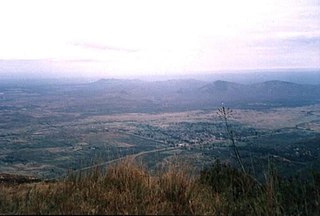
Mazinde is a community in the Korogwe District of the Tanga Region of Tanzania.

Sisal production in Tanzania began in the late 19th century by the German East Africa Company. Sisal was continually produced during the German administration and the British administration and was the colony's largest export highly prized for use in cordage and carpets worldwide. At the time of independence in 1961, Tanzania was the largest exporter of Sisal in the world and the industry employed over 1 million farmers and factory workers.

Agriculture is the main part of Tanzania's economy. As of 2016, Tanzania had over 44 million hectares of arable land with only 33 percent of this amount in cultivation. Almost 70 percent of the poor population live in rural areas, and almost all of them are involved in the farming sector. Land is a vital asset in ensuring food security, and among the nine main food crops in Tanzania are maize, sorghum, millet, rice, wheat, beans, cassava, potatoes, and bananas. The agricultural industry makes a large contribution to the country's foreign exchange earnings, with more than US$1 billion in earnings from cash crop exports.